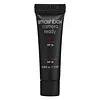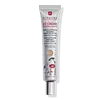What's inside
What's inside
 Key Ingredients
Key Ingredients

 Benefits
Benefits

 Concerns
Concerns

 Ingredients Side-by-side
Ingredients Side-by-side

Water
Skin ConditioningDimethicone
EmollientButylene Glycol
HumectantPhenyl Trimethicone
Skin ConditioningPentylene Glycol
Skin ConditioningGlyceryl Stearate
EmollientBehenyl Alcohol
EmollientTrioctyldodecyl Citrate
EmollientPolymethylsilsesquioxane
Octyldodecyl Stearoyl Stearate
EmollientPEG-40 Stearate
EmulsifyingPolyglyceryl-10 Pentastearate
Skin ConditioningAmmonium Acryloyldimethyltaurate/Vp Copolymer
Triticum Vulgare Germ Extract
Skin ConditioningHordeum Vulgare Extract
EmollientCucumis Sativus Fruit Extract
EmollientLaminaria Saccharina Extract
Skin ProtectingPyrus Malus Fruit Extract
Skin ConditioningScutellaria Baicalensis Root Extract
AstringentPolyquaternium-51
Skin ConditioningAcetyl Hexapeptide-8
HumectantTrehalose
HumectantOryzanol
Skin ConditioningOctyldodecyl Neopentanoate
EmollientUrea
BufferingPolyglyceryl-6 Polyricinoleate
EmulsifyingPropylene Glycol Laurate
Skin ConditioningGlycyrrhetinic Acid
Skin ConditioningTocopheryl Acetate
AntioxidantSucrose
HumectantGlycerin
HumectantSodium Stearoyl Lactylate
EmulsifyingCaffeine
Skin ConditioningLinoleic Acid
CleansingCholesterol
EmollientLecithin
EmollientSqualane
EmollientSodium PCA
HumectantIsopropyl Titanium Triisostearate
EmollientPropylene Glycol Stearate
Skin ConditioningStearic Acid
CleansingPolysorbate 20
EmulsifyingSorbitan Laurate
EmulsifyingXanthan Gum
EmulsifyingAluminum Hydroxide
EmollientSodium Hyaluronate
HumectantSilica
AbrasiveDisodium EDTA
Pentaerythrityl Tetra-Di-T-Butyl Hydroxyhydrocinnamate
AntioxidantSodium Dehydroacetate
PreservativeChlorphenesin
AntimicrobialPhenoxyethanol
PreservativeCI 77891
Cosmetic ColorantZinc Oxide
Cosmetic ColorantCI 77491
Cosmetic ColorantCI 77492
Cosmetic ColorantCI 77499
Cosmetic ColorantMica
Cosmetic ColorantWater, Dimethicone, Butylene Glycol, Phenyl Trimethicone, Pentylene Glycol, Glyceryl Stearate, Behenyl Alcohol, Trioctyldodecyl Citrate, Polymethylsilsesquioxane, Octyldodecyl Stearoyl Stearate, PEG-40 Stearate, Polyglyceryl-10 Pentastearate, Ammonium Acryloyldimethyltaurate/Vp Copolymer, Triticum Vulgare Germ Extract, Hordeum Vulgare Extract, Cucumis Sativus Fruit Extract, Laminaria Saccharina Extract, Pyrus Malus Fruit Extract, Scutellaria Baicalensis Root Extract, Polyquaternium-51, Acetyl Hexapeptide-8, Trehalose, Oryzanol, Octyldodecyl Neopentanoate, Urea, Polyglyceryl-6 Polyricinoleate, Propylene Glycol Laurate, Glycyrrhetinic Acid, Tocopheryl Acetate, Sucrose, Glycerin, Sodium Stearoyl Lactylate, Caffeine, Linoleic Acid, Cholesterol, Lecithin, Squalane, Sodium PCA, Isopropyl Titanium Triisostearate, Propylene Glycol Stearate, Stearic Acid, Polysorbate 20, Sorbitan Laurate, Xanthan Gum, Aluminum Hydroxide, Sodium Hyaluronate, Silica, Disodium EDTA, Pentaerythrityl Tetra-Di-T-Butyl Hydroxyhydrocinnamate, Sodium Dehydroacetate, Chlorphenesin, Phenoxyethanol, CI 77891, Zinc Oxide, CI 77491, CI 77492, CI 77499, Mica
Water
Skin ConditioningCyclomethicone
EmollientDipropylene Glycol
HumectantGlycerin
HumectantPEG-10 Dimethicone
Skin ConditioningMethyl Trimethicone
Skin ConditioningC12-15 Alkyl Benzoate
AntimicrobialDimethicone
EmollientDisteardimonium Hectorite
StabilisingMagnesium Sulfate
Vinyl Dimethicone/Methicone Silsesquioxane Crosspolymer
Centella Asiatica Extract
CleansingMel
EmollientTalc
AbrasiveDimethicone/Vinyl Dimethicone Crosspolymer
Skin ConditioningPhenoxyethanol
PreservativeEthylhexylglycerin
Skin ConditioningTrihydroxystearin
Skin ConditioningButylene Glycol
HumectantMica
Cosmetic ColorantAluminum Hydroxide
EmollientPalmitic Acid
EmollientStearic Acid
CleansingPolyester-1
Silica Dimethyl Silylate
EmollientTocopheryl Acetate
AntioxidantMethicone
EmollientTocopherol
AntioxidantParfum
MaskingHexyl Cinnamal
PerfumingAlpha-Isomethyl Ionone
PerfumingLinalool
PerfumingCitronellol
PerfumingGeraniol
PerfumingEugenol
PerfumingLimonene
PerfumingCI 77492
Cosmetic ColorantCI 77491
Cosmetic ColorantCI 77499
Cosmetic ColorantWater, Cyclomethicone, Dipropylene Glycol, Glycerin, PEG-10 Dimethicone, Methyl Trimethicone, C12-15 Alkyl Benzoate, Dimethicone, Disteardimonium Hectorite, Magnesium Sulfate, Vinyl Dimethicone/Methicone Silsesquioxane Crosspolymer, Centella Asiatica Extract, Mel, Talc, Dimethicone/Vinyl Dimethicone Crosspolymer, Phenoxyethanol, Ethylhexylglycerin, Trihydroxystearin, Butylene Glycol, Mica, Aluminum Hydroxide, Palmitic Acid, Stearic Acid, Polyester-1, Silica Dimethyl Silylate, Tocopheryl Acetate, Methicone, Tocopherol, Parfum, Hexyl Cinnamal, Alpha-Isomethyl Ionone, Linalool, Citronellol, Geraniol, Eugenol, Limonene, CI 77492, CI 77491, CI 77499
 Reviews
Reviews

Ingredients Explained
These ingredients are found in both products.
Ingredients higher up in an ingredient list are typically present in a larger amount.
Aluminum Hydroxide is a form of aluminum. It can be naturally found in nature as the mineral gibbsite. In cosmetics, Aluminum Hydroxide is used as a colorant, pH adjuster, and absorbent.
As a colorant, Aluminum Hydroxide may add opacity, or reduce the transparency. Aluminum hydroxide is contains both basic and acidic properties.
According to manufacturers, this ingredient is an emollient and humectant. This means it helps hydrate the skin.
In medicine, this ingredient is used to help relieve heartburn and help heal ulcers.
There is currently no credible scientific evidence linking aluminum hydroxide in cosmetics to increased cancer risk.
Major health organizations allow the use of aluminum hydroxide in personal care products and have not flagged it as a carcinogenic risk at typical usage levels.
Learn more about Aluminum HydroxideButylene Glycol (or BG) is used within cosmetic products for a few different reasons:
Overall, Butylene Glycol is a safe and well-rounded ingredient that works well with other ingredients.
Though this ingredient works well with most skin types, some people with sensitive skin may experience a reaction such as allergic rashes, closed comedones, or itchiness.
Learn more about Butylene GlycolCi 77491 is also hydrated iron III oxide. It's sole purpose is to give a red/pink hue to products.
Iron III oxides are classified as inorganic chemicals for coloring.
Synthetically created Ci 77491 is considered safer than those naturally found. This is because the synthetically created version may contain less impurities. Iron oxides are generally non-toxic and non-allergenic.
Learn more about CI 77491Ci 77492 is also hydrated iron III oxide. It's sole purpose is to give a yellow hue to products.
Iron III oxides are classified as inorganic chemicals for coloring.
Synthetically created Ci 77492 is considered safer than those naturally found. This is because the synthetically created version may contain less impurities. Iron oxides are generally non-toxic and non-allergenic.
Learn more about CI 77492Ci 77499 is also hydrated iron III oxide. It is created from mixing red and black iron oxides. This helps give shades of darkness to a product.
Iron III oxides are classified as inorganic chemicals for coloring.
Dimethicone is a type of synthetic silicone created from natural materials such as quartz.
What it does:
Dimethicone comes in different viscosities:
Depending on the viscosity, dimethicone has different properties.
Ingredients lists don't always show which type is used, so we recommend reaching out to the brand if you have questions about the viscosity.
This ingredient is unlikely to cause irritation because it does not get absorbed into skin. However, people with silicone allergies should be careful about using this ingredient.
Note: Dimethicone may contribute to pilling. This is because it is not oil or water soluble, so pilling may occur when layered with products. When mixed with heavy oils in a formula, the outcome is also quite greasy.
Learn more about DimethiconeGlycerin is already naturally found in your skin. It helps moisturize and protect your skin.
A study from 2016 found glycerin to be more effective as a humectant than AHAs and hyaluronic acid.
As a humectant, it helps the skin stay hydrated by pulling moisture to your skin. The low molecular weight of glycerin allows it to pull moisture into the deeper layers of your skin.
Hydrated skin improves your skin barrier; Your skin barrier helps protect against irritants and bacteria.
Glycerin has also been found to have antimicrobial and antiviral properties. Due to these properties, glycerin is often used in wound and burn treatments.
In cosmetics, glycerin is usually derived from plants such as soybean or palm. However, it can also be sourced from animals, such as tallow or animal fat.
This ingredient is organic, colorless, odorless, and non-toxic.
Glycerin is the name for this ingredient in American English. British English uses Glycerol/Glycerine.
Learn more about GlycerinMica is a naturally occurring mineral used to add shimmer and color in cosmetics. It can also help improve the texture of a product or give it an opaque, white/silver color.
Serecite is the name for very fine but ragged grains of mica.
This ingredient is often coated with metal oxides like titanium dioxide. Trace amounts of heavy metals may be found in mica, but these metals are not harmful in our personal products.
Mica has been used since prehistoric times throughout the world. Ancient Egyptian, Indian, Greek, Roman, Aztec, and Chinese civilizations have used mica.
Learn more about MicaPhenoxyethanol is a preservative that has germicide, antimicrobial, and aromatic properties. Studies show that phenoxyethanol can prevent microbial growth. By itself, it has a scent that is similar to that of a rose.
It's often used in formulations along with Caprylyl Glycol to preserve the shelf life of products.
Stearic Acid is a fatty acid. It is an emollient, emulsifier, and texture enhancer.
As an emollient, stearic acid helps soften skin. It aids the skin's protective barrier by preventing water loss. It also provides a gentle cleansing effect without stripping away natural oils.
Stearic acid may also be used to enhance the texture of products. It can add volume and stabilize ingredients such as water and oil. This can help water and oil ingredients from separating.
Sources of stearic acid include animal or vegetable fats/oils such as coconut or shea. It can be naturally found in butter, cocoa butter, shea butter, vegetable fats, and animal tallow.
This ingredient may not be Malassezia folliculitis, or fungal-acne safe.
Learn more about Stearic AcidTocopheryl Acetate is AKA Vitamin E. It is an antioxidant and protects your skin from free radicals. Free radicals damage the skin by breaking down collagen.
One study found using Tocopheryl Acetate with Vitamin C decreased the number of sunburned cells.
Tocopheryl Acetate is commonly found in both skincare and dietary supplements.
Learn more about Tocopheryl AcetateWater. It's the most common cosmetic ingredient of all. You'll usually see it at the top of ingredient lists, meaning that it makes up the largest part of the product.
So why is it so popular? Water most often acts as a solvent - this means that it helps dissolve other ingredients into the formulation.
You'll also recognize water as that liquid we all need to stay alive. If you see this, drink a glass of water. Stay hydrated!
Learn more about Water